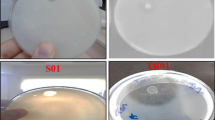Summary
Thrombus disease, one of the common cardiovascular diseases, has attracted worldwide attention for its rising mortality and morbidity. Due to the distinct shortages of current fibrinolytic drugs, new fibrinolytic agents warrant investigation. In this study, 8 fibrinolytic enzyme-producing strains were isolated from Douchi—a traditional Chinese food, and strain XY-1 which produced the largest amount of the enzyme was chosen for the following experiments. The enzyme produced by strain XY-1 was named Douchi fibrinolytic enzyme (DFE). We optimized the liquid culture medium of strain XY-1 for enzyme production using Plackett-Burman and Box-Behnken design. The predicted maximal DFE yield was 19.78 FU/mL with 11.4 g/L peptone, 0.5 g/L magnesium sulfate and 1 g/L sodium chloride. However, we acquired maximal production of 21.33 FU/mL in actual experiments, equal to 107.84% of the theoretical value, and the yield had been increased by 79.55% as compared to the yield of un-optimized culture. It was demonstrated that the combined use of Plackett-Burman design and response surface methodology in fermentation optimization can effectively and rapidly increase DFE production.
Similar content being viewed by others
References
Mine Y, Wong AH, Jiang B, et al. Fibrinolytic enzymes in Asian traditional fermented foods. Food Res Int, 2005,38(3):243–250
Peng Y, Yang XJ, Zhang YZ. Microbial fibrinolytic enzymes: an overview of source, production, properties, and thrombolytic activity in vivo. Appl Microbiol Biotechnol, 2005,69(2):126–132
Sumi H, Hamada H, Tsushima H, et al. A novel fibrinolytic enzyme (nattokinase) in the vegetable cheese Natto; a typical and popular soybean food in the Japanese diet. Cell Mol Life Sci, 1987,43(10):1110–1111
Sumi H, Hamada H, Nakanishi K, et al. Enhancement of the fibrinolytic activity in plasma by oral administration of nattokinase. Acta Haematol, 1990,84(3):139–143
Urano T, Ihara H, Umemura K, et al. The profibrinolytic enzyme subtilisin NAT purified from Bacillus subtilis cleaves and inactivates plasminogen activator inhibitor type 1. J Biol Chem, 2001,276(27):24 690–24 696
Fujita M, Hong K, Ito Y, et al. Transport of nattokinase across the rat intestinal tract. Biol Pharm Bull, 1995,18(9):1194–1196
Peng Y, Huang Q, Zhang RH, et al. Purification and characterization of a fibrinolytic enzyme produced by Bacillus amyloliquefaciens DC-4 screened from douchi, a traditional Chinese soybean food. Comp Biochem Phys B, 2003,134(1):45–52
Astrup T, Mullertz S. The fibrin plate method for estimating fibrinolytic activity. Arch Biochem Biophys, 1952,40(2):346–351
Buchanan RE, Gibbons NE. Bergey’s Manual of Systematic Bacteriology (Chinese edition). 8th ed. New York: Springer-Verlag, 1984,225–228
Wu SY. Optimization of nutritional conditions for Nattokinase production by an isolated Bacillus subtilis from natto health food. Thesis for Master Science, Tatung University, 2005
Kim SH, Choi NS. Purification and characterization of subtilisin DJ-4 secreted by Bacillus sp strain DJ-4 screened from Doen-Jang. Biosci Biotech Bioch, 2000,64(8):1722–1725
Kim W, Choi K, Kim Y, et al. Purification and characterization of a fibrinolytic enzyme produced from Bacillus sp. strain CK 11–4 screened from Chungkook-Jang. Appl Environ Microb, 1996,62(7):2482–2488
Kim HK, Kim GT, Kim DK, et al. Purification and characterization of a novel fibrinolytic enzyme from Bacillus sp. KA38 originated from fermented fish. J Ferment Bioeng, 1997,84(4):307–312
Chang CT, Huang YF, Chung YC. Purification and characterization of fibrinolytic enzyme from Bacillus subtilis-fermented red beans. J Biotechnol, 2010,150(Supplement):305–306
Sugimoto S, Fujii T, Morimiya T, et al. The fibrinolytic activity of a novel protease derived from a tempeh producing fungus, Fusarium sp. BLB. Biosci Biotechnol Biochem, 2007,71(9):2184–2189
Plackett RL, Burman JP. The design of optimum multifactorial experiments. Biometrika, 1946,33(4):305–325
Box GEP, Behnken DW. Some new three level designs for the study of quantitative variables. Technometrics, 1960,2(4):455–475
Ku TW, Tsai RL, Pan TM. A simple and cost-saving approach to optimize the production of subtilisin NAT by submerged cultivation of Bacillus subtilis natto. J Agric Food Chem, 2009,57(1):292–296
Chen PT, Chiang CJ, Chao YP. Medium optimization for the production of recombinant nattokinase by Bacillus subtilis using response surface methodology. Biotechnol Progr, 2007,23(6):1327–1332
Author information
Authors and Affiliations
Corresponding authors
Additional information
This project was supported by a grant from the Ministry of Environmental Protection (No. 200909036).
Rights and permissions
About this article
Cite this article
Zhang, X., Yun, Lj., Peng, Lb. et al. Optimization of Douchi fibrinolytic enzyme production by statistical experimental methods. J. Huazhong Univ. Sci. Technol. [Med. Sci.] 33, 153–158 (2013). https://doi.org/10.1007/s11596-013-1089-8
Received:
Published:
Issue Date:
DOI: https://doi.org/10.1007/s11596-013-1089-8




